The Apple Thunderbolt Display Review
by Anand Lal Shimpi on September 23, 2011 2:56 AM EST- Posted in
- Displays
- Mac
- Apple
- Thunderbolt
- Thunderbolt Display
Dissection
If you haven't gathered by now, the Thunderbolt Display isn't a regular monitor - it has a lot of components inside that you'd typically only find in a full fledged computer. Being the curious cat I am, I wanted to see inside. Apple isn't too fond of us poking around inside their review samples, but luckily the Crabtree Valley Mall Apple Store just got Thunderbolt Displays in so I hopped in the practical-wagon and grabbed one in the name of science.
Apple has an incredible fascination with using magnets in its designs. What it enables are some pretty neat enclosures, particularly on its displays. The glass front of the Thunderbolt Display is actually identical to what's used on the 27-inch LED Cinema Display and iMac. The glass is held to the chassis via several very strong magnets. To remove the glass you'll need to use suction cups:
Behind the glass front is the actual LCD panel itself. The LCD and backlight are enclosed in a single unit. What we're interested in is behind the LCD however. Unplug a few cables and remove a grounding screw and the LCD unit is easily cast aside. Behind it are two discrete PCBs:
The PCB on the left is the monitor's power supply. Looking at another half-wave rectifier isn't on my to-do list this time, so we turn our attention to the right PCB. This is the board that handles all of the IO on the Thunderbolt Display. All of the screws we've removed thus far just need a T9/T10 torx bit.
The Thunderbolt Display's motherboard is full of controllers driving all of the rear facing IO ports. Contrary to what we originally posted, I now believe this is the same Light Ridge controller we've seen on other Macs (not the MacBook Air):
The external Thunderbolt cable actually continues inside the display and ends up at an internal Thunderbolt port. The cable terminates at the port and then is routed via traces on the PCB to the Eagle Ridge chip:
The other controllers are sprinkled around the PCB, although there's enough space between all of them to make routing nice and easy. The beauty of designing PCBs for monitors like this is you have tons of room to work with.
Pericom provides a PCIe x1 to 4-USB-port adapter on the board:
The internal speakers are driven by a combination of an ST-NXP 0161ET USB audio controller and an Analog Devices ADAV4601 audio processor. The ST-NXP controller sits on an internal USB interface, while the ADAV4601 dangles off of it.
That wraps it up for the front of the PCB. Around back there's a collection of stereo amps as well as the GigE (Broadcom BCM57761) and FW800 (LSI L-FW643E-2) controllers.
There's nothing immediately apparent in the PCB design that would point to the cause of the issue we saw with the Promise Pegasus interfering with the Thunderbolt Display's USB audio controller. The root cause must be exclusive to the Pegasus.








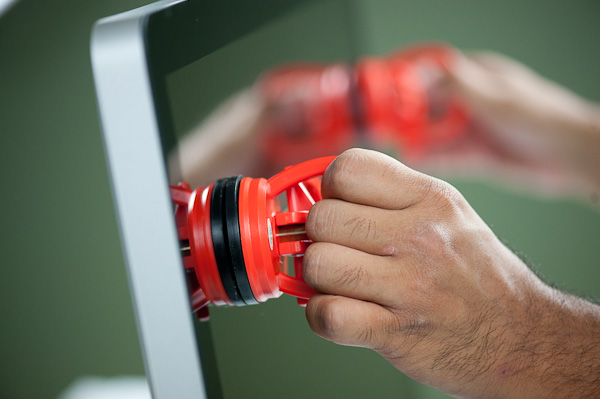
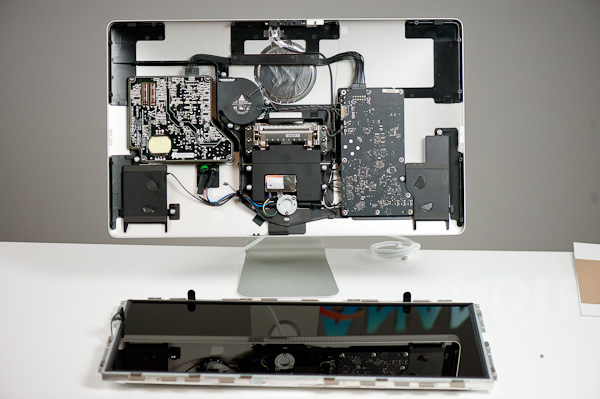
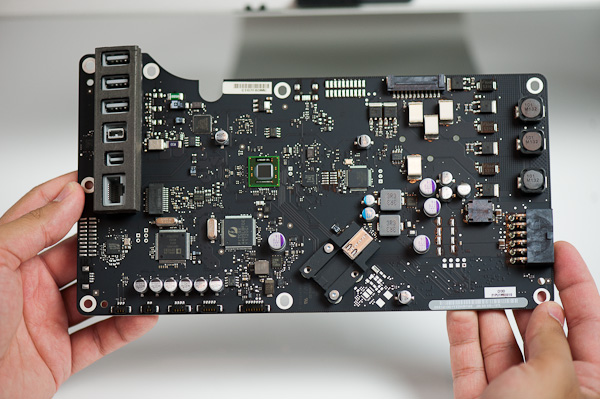
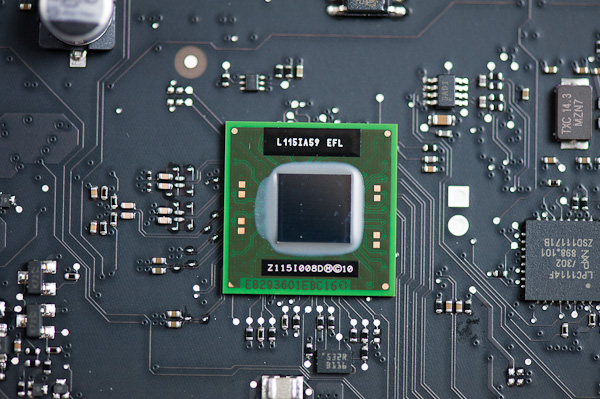
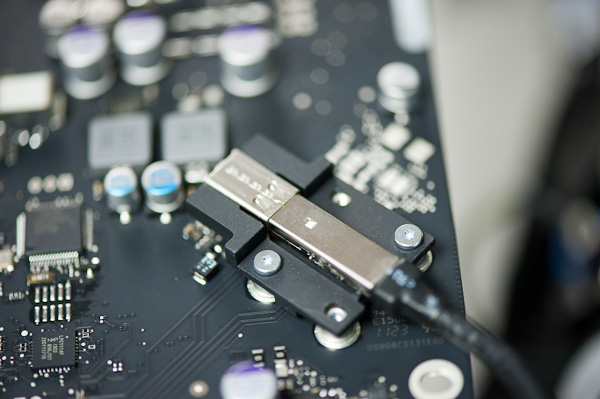
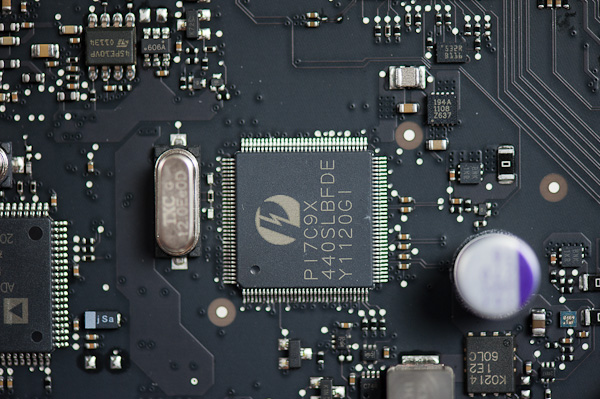
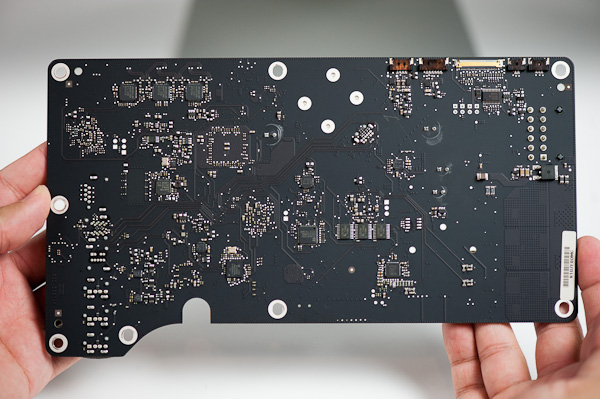
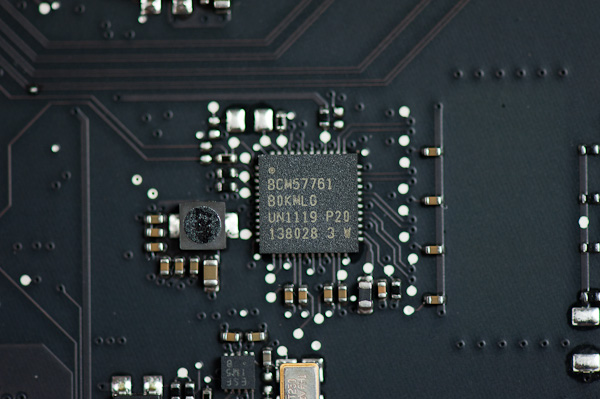








275 Comments
View All Comments
repoman27 - Tuesday, September 27, 2011 - link
This is the first display to include ports that have their own host controllers. All other displays either offer just multiple video input ports, or have an internal USB hub and various USB devices that are connected to the USB host controller on a PC via a separate cable. Some also have an audio input as well for a connection to a separate audio output on the PC. So yes, whole different ball game here.I'd rather have a $120k car that doesn't have a stereo or floor mats because they weigh too much. ;-)
I also like displays with height adjustment, but, and not to sound like a total Apple apologist here, Apple generally makes pretty good decisions about which features to include and which to leave out. Whenever you design an electronic gadget you have to make compromises. You can't cram every feature on the market into one device that's smaller and more beautiful than all the others and then sell it for an absurdly low price. The ATD is a pretty balanced package overall. Apple also doesn't have any currently shipping, proven, height-adjustable display stand designs at the moment. If they did, and simply omitted it for this product, it would be far more egregious.
Yeah, stupid consumer HDTV market completely killing the mid-range display market.
AnnonymousCoward - Tuesday, September 27, 2011 - link
The user doesn't care if there's a hub or host directly behind the USB port. It's a friggen USB port, just like my monitor has. And it'd be better if it were USB3, and if there were more than 3 ports. Plug in a mouse and keyboard, and you're quickly left with 1 remaining port, which isn't enough.You don't care to have a stereo in your car? Very odd. I'll take a 15k car with good sound over a silent 120k.
Dell has had their swivel adjustments figured out for several monitor generations. Apple has no excuse, and makes poor feature decisions over and over. Like back when their iPod Shuffle came out, for $90 or whatever and no screen, compared to another brand that cost $35, OLED screen, superior battery life, and functions like a flash drive without iTunes. In addition, Apple's price margins are so high that they can easily afford to add vital features, when competitors have them and sell for less.
repoman27 - Tuesday, September 27, 2011 - link
Of course you don't care how things work, you just buy based on bullet points put forth buy the marketers.How's the throughput on the Gigabit Ethernet port in your display? Does your display have any USB 3.0 ports? Does the PC that it's connected to even have any?
Yeah, and what you consider poor feature decisions have propelled Apple to the #1 ranking market cap in the world. Clearly shareholders are liking the feature set. How's the company that made that other brand doing these days? Dominating the market are they?
AnnonymousCoward - Tuesday, September 27, 2011 - link
Apple is "#1 market cap" because of their marketing department. NOT feature set, nor value.Constructor - Thursday, September 29, 2011 - link
You keep telling yourself that.In the real world, it is actually hard to make the right tradeoffs in product development. And cramming the absolute maximum number of paper features into a product quite often does a disservice to its actual usability and practical usefulness.
Apple's meteoric rise and sky-high user loyalty in large part comes from them in fact making the right decisions in most of these tradeoffs.
"Marketing" is a rather helpless catch-all pseudo-explanation for what many people (and even most competitors) simply fail to grasp. Which is why Apple is successful, and they are not.
AnnonymousCoward - Friday, September 30, 2011 - link
"paper features""disservice to its actual usability and practical usefulness."
-Oh, you mean like a mouse with a right-click button? Yeah, that's quite the paper feature with no practical usefulness!
-Or maybe like putting a screen on an MP3 player. That's yet another worthless paper feature!
-Or a monitor stand with height adjustment. That only looks good on paper! There's no practical usefulness here because every MacHead has a height-adjustable desk!
And don't get me started on the lack of value. You can get a new 15.6" laptop with a C2D-based Intel processor for $280; Apple laptops start at $1000. A while back you could get Apple's 30" (which used an outdated LG panel) for $2000, versus Dell's 30" (with a newer and better LG panel) for $1500, and it had swivel.
I credit the vast majority of Apple's success to their brilliant mass marketing.
crispbp04 - Sunday, September 25, 2011 - link
i just dock my computer and don't have to get flustered over seven cables. snap in and move on. snap off and leave.Constructor - Sunday, September 25, 2011 - link
And all the while there's the massive docking station cluttering up your desk. Which can't be used with any other computer and cannot be adapted to should you need anything it doesn't happen to provide.I'm not saying that it can't be useful, just that Thunderbolt is quite a bit more flexible, more powerful and more convenient.
dsumanik - Tuesday, September 27, 2011 - link
How is that different from a piece of wood or a stack of books for the display to sit on because there is no height adjustment?Constructor - Tuesday, September 27, 2011 - link
You'll need a display in addition to your docking station. The TBD already covers the docking needs, and you can still use the Air's keyboard and trackpad if you like, since there's only one thin cable going out from it, not much different from a USB keyboard cable.And as I explained before: Height adjustment built into the regular stands is usually too limited to be really useful where it's actually needed, and still fragile and wobbly at the same time (which is two things the iMac / Thunderbolt Display stand most certainly is not).
Theoretically demanding all kinds of things is one thing. Ticking them off on a theoretical spec sheet is another.
But the actual, practical reality is usually a completely different thing again. And that is what you have to deal with when you're actually constructing real-life hardware. It's not nearly as simple as is looks from the outside (I'm developing software, hardware and sometimes mechanical components for a living myself).
Bitching is easy. Finding really good solutions for difficult problems is not.